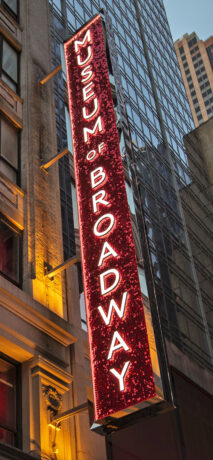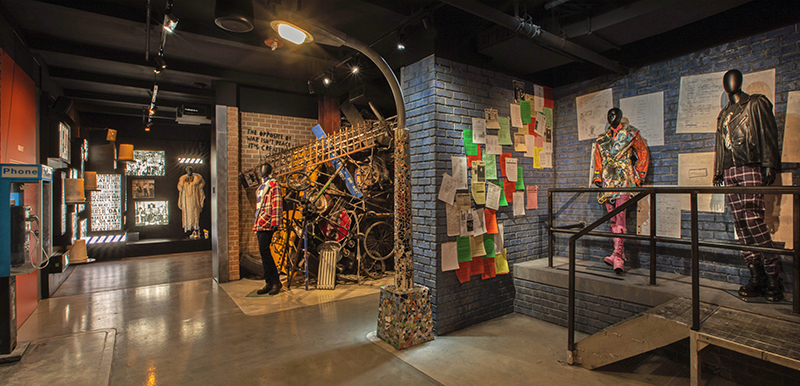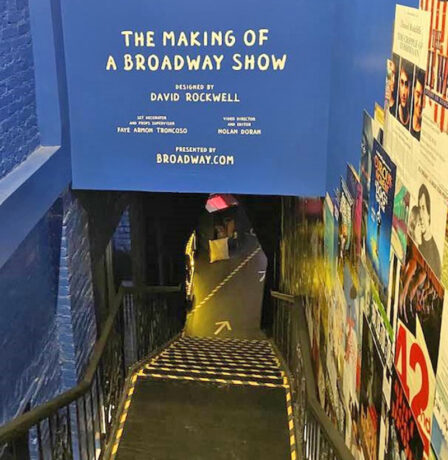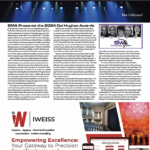
The Museum of Broadway, an immersive and interactive theatrical experience devoted to all things Broadway, opened in New York City on November 15. Located at 145 West 45th Street, in the heart of the Broadway theater district, the Museum features the work of dozens of designers, theatermakers, artisans, and theater historians. Visitors take a journey along the timeline of Broadway, from its birth to present day, exploring the past, present, and future of Broadway in this deep diving, behind the curtain look at the shows and their creative teams.
The Museum of Broadway was founded by Tony Award-winning producer, Julie Boardman, and Diane Nicoletti, founder of the experiential agency Rubik Marketing. This visual history of Broadway is presented by highlighting groundbreaking moments through a series of exhibits that showcase spectacular costumes, props, renderings, rare photos, videos, and more. Some of the exhibits and immersive experiences featured include The Phantom of The Opera, The Lion King, HAIR, The Ziegfeld Follies, Show Boat, Oklahoma!, The Wiz, and Rent, among many, many more.
The Making of a Broadway Show exhibit is of particular interest to many creatives and production people as it celebrates the wealth of roles that play out only behind-the-scenes of Broadway. Here the Museum honors the community of talented off-stage professionals who bring each Broadway show to life. This standout exhibit was designed by Scenic Designer and Architect David Rockwell with Faye Armon-Troncoso serving as Set Decorator & Prop Supervisor. Stage Directions in PLSN caught up with her upon the opening of the museum to learn more about her work on this part of the museum.
Curation Approach
Armon-Troncoso worked closely with Rockwell to source all of the artifacts for The Making of a Broadway Show from a wide variety of artists and resources. “In a sense, I curated the exhibit with all of the stuff to fill the cubbies and how to support the messages to the guests,” she says. “One of the major things that I wanted to do was to not leave out anybody—or any discipline; I wanted all the disciplines represented and out in front. Like the unsung heroes—the stage managers, for instance, and how much time they put into a show. We have a large poster that lists how many hours a day, and how long the process is for stage managers. I thought that it was also really important to include not only the designers—but also include the associate designers; unions; dressers; wardrobe, and prop supervisors, photographers—all the people that support a production. And not just the people on the poster, or the title page of the Playbill.”
While she had not worked on a museum project prior to this, Armon-Troncoso, who works in props and set decoration for theater and television, felt the process was similar in terms of acquiring the artifacts and set decoration for the exhibit. She does note one difference, “It was not really about props, it was more about artifacts. So, I got to speak with all of the artisans involved. For instance, we have John Lee Beatty who I spoke with about his process and also, we’ve got some drawings, some molding options, fabric swatches, and sketches. In addition, I thought that it would be cool to have John Lee give us 10 tips on what he’s learned though his years doing Broadway, so he hand wrote some tips, which we included in his section. In the Jane Greenwood section, we highlighted the costume creation process for The Little Foxes, with the green dress that both Laura Linney and Cynthia Nixon wore. You see a photo of them both in the dress and we see the muslin made by Eric Winterling, as well as Jane’s sketch of the dress, the measurements, and the production calendar. Jane also wrote out 10 tips on what she’s learned.”

Design Process
Along with costumes and scenic, the design disciplines of lighting, projection, and sound are displayed and explored. Lighting and projection are highlighted with references from the recent production of Beetlejuice. “We have a lighting booth with a lighting console and a display of how lighting and projections work. We show Ken Posner’s lighting and Peter Nigrini’s projection designs mapped onto a white model of David Korin’s set. We have paperwork like magic sheets and the light plot. We have plots for A Chorus Line and other shows as well. We have a display showing how Scenic Arts Studios makes their drops. You get to see the process from the charcoal grid then starting to pounce, and then to paint. We get to show their tools. Also, we have set models and paint samples from Bob Crowley for Aladdin. Sam Ellis from Hudson Theatricals gave us 10 tips about being a Production Manager; and there are 10 tips from a Company Manager. It’s all about showing the process; my focus was dressing this area with people and their processes. I worked with Nolan Doran, our Video Director, who created great videos with all these artisans and designers. He captured hours of interviews where you see people giving their advice about how—and what to do—to get into working on a Broadway show.
There were, as with any show, a number of challenges and hard work involved in pulling together and collecting all the materials for this exhibition project, similar to when pulling together the props for a play or musical. Armon-Troncoso did encounter one unique wrinkle on this job—working on an active construction site. “We were installing our exhibits while the building was under construction,” she recalls. “I’ve never worked like that, and it was a bit challenging. Another thing I found was that I got a little scared in the process because I worried that I would leave somebody out. That I wouldn’t be able to include everybody, or every discipline. I was kind of paralyzed for a little bit, but I got through it once I started creating the displays and each person liked them. I thought, ‘okay, so we’re onto something here.’”

Giving Credit
She commends both Boardman and Nicoletti, the creators of The Museum of Broadway, for recognizing her work in a way that she has not previously been identified before on Broadway or Off-Broadway productions. “When you enter our The Making of A Broadway Show exhibit, you open up the stage door and walk in. You see a call board, and when you start looking around above the stairs down to the exhibit you see the title of the exhibit and the credits—‘Designed by David Rockwell’, and then right underneath to the left is my name and title, Set Decoration and Props Supervisor, then to the right is the credit for Nolan Doran, Video Director and Editor. To have called us out that way just meant the world to me. I just wanted to say thanks because I’ve never had that type of credit for anything I’ve done in the theater.” That recognition of the roles often unseen is a perfect start to an exhibit all about those roles.
For Armon-Troncoso this job was a real pleasure as she concludes, “working with The Rockwell Group was awesome. They designed this great space and I got to add the meat and potatoes with all of these artifacts of the shows and all of the people that make up the ecosystem of a Broadway show. Also, getting to reconnect with old friends too, like Rae Smith who I did War Horse with, and Todd Rosenthal—being able to include their scenic design work in the exhibit. Connecting with Rachel Hauck and getting her Hadestown model and paint elevations. Having work from Derek McLane, Robin Wagner, and John Arnone’s original drawings from The Who’s Tommy was very cool. To round up the ideas, and everyone being so excited about it and wanting to be a part of it. It meant so much to me to be involved with this project. It was just such an honor.”


